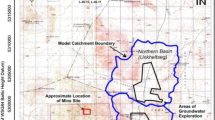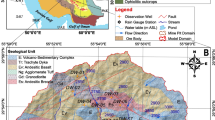Abstract
The Çeltikçi Coal Basin is a newly discovered coal basin in Central Anatolia where 11 years of open-cut mining has been planned. The bulk of the mining will be conducted below the regional water table; hence, determination of the dewatering requirements and proper design of the dewatering wells plays a critical role. This study (i) defined the dewatering requirements of the open-pit mine, (ii) established a dewatering well design for the area, and (iii) assessed the anticipated impacts of the dewatering activities. For this purpose, a 3-D numerical groundwater flow model was developed using the FEFLOW software. Yearly dewatering requirements were determined under transient conditions. For the dewatering well simulations, two types of dewatering wells were considered: permanent wells located at the open pit boundary that would increase in number as the excavation proceeds and wells located at the periphery of the yearly excavated area that would be operational for about two years. The simulation results indicated that 894 wells were required to satisfy dry working conditions; the average pumping rate throughout the mine life was calculated as 322 L/s. The impacts of open-pit dewatering on groundwater resources were assessed in terms of spring discharge and base flow rates in the nearby Kirmir stream. As a result of dewatering, most of the village water supply springs and fountains will dry up in the area. In addition, the base flow rates to the Kirmir stream will be decreased by 15%.
Resumen
La cuenca carbonífera de Çeltikçi es una cuenca de carbón recién descubierta en Anatolia Central en la que se han previsto 11 años de explotación a cielo abierto. La mayor parte de la explotación se llevará a cabo por debajo del nivel freático de la región, por lo que la determinación de los requisitos de desagüe y el diseño adecuado de los pozos de desagote desempeñan un papel fundamental. Este estudio (i) definió los requisitos de desagote de la mina a cielo abierto, (ii) estableció un diseño de pozos de desagote para la zona y (iii) evaluó los impactos previstos de las actividades de desagote. Para ello, se elaboró un modelo numérico tridimensional de flujo de aguas subterráneas utilizando el software FEFLOW. Se determinaron las necesidades anuales de desagote en condiciones transitorias. Para las simulaciones de pozos de desagote, se consideraron dos tipos de pozos de desagote: pozos permanentes situados en el límite del tajo abierto que aumentarían en número a medida que la excavación avanzara y pozos situados en la periferia de la zona excavada anualmente que estarían operativos durante unos dos años. Los resultados de la simulación indicaron que se necesitaban 894 pozos para satisfacer las condiciones de trabajo en seco; la tasa media de bombeo a lo largo de la vida de la mina se calculó en 322 L/s. Se evaluaron los impactos del desagote del tajo abierto en los recursos de agua subterránea en términos de descarga de manantiales y caudales base en el cercano arroyo Kirmir. Como consecuencia del desagote, la mayoría de los manantiales y fuentes de suministro de agua del pueblo se secarán en la zona. Además, los caudales de base del arroyo Kirmir disminuirán en un 15%.
Zusammenfassung
Das Çeltikçi-Kohlerevier ist ein neu entdecktes Kohlebecken in Zentralanatolien, in dem für 11 Jahre tagebaumäßige Gewinnung geplant wird. Der größte Teil des Abbaus wird unterhalb des regionalen Grundwasserspiegels erfolgen. Daher spielen die Festlegung der Entwässerungsanforderungen und die richtige Auslegung der Entwässerungsbrunnen eine entscheidende Rolle. Im Rahmen dieser Studie wurden (i) die Entwässerungsanforderungen für den Tagebau definiert, (ii) ein Entwässerungsbrunnenkonzept für das Gebiet erstellt und (iii) die zu erwartenden Auswirkungen der Entwässerungsaktivitäten bewertet. Zu diesem Zweck wurde ein numerisches 3-D-Grundwasserströmungsmodell mit der Software FEFLOW entwickelt. Die jährlichen Entwässerungsanforderungen wurden unter instationären Bedingungen festgelegt. Für die Entwässerungsbrunnensimulation wurden zwei Arten von Entwässerungsbrunnen berücksichtigt: permanente Brunnen an der Tagebaugrenze, deren Anzahl mit dem Abbaufortschritt zunehmen würde und Brunnen am Rande der jährlichen Abbauflächen, die etwa zwei Jahre lang in Betrieb sein würden. Aus den Simulationsergebnissen geht hervor, dass 894 Brunnen erforderlich sind, um trockene Arbeitsbedingungen zu gewährleisten. Die durchschnittliche Pumprate über die gesamte Tagebaudauer wurde mit 322 l/s berechnet. Die Auswirkungen der Tagebauentwässerung auf die Grundwasserressourcen wurden im Hinblick auf die Quellschüttung und die Grundwassermenge des nahe gelegenen Kirmirbachs bewertet. Infolge der Entwässerung werden die meisten Quellen und Brunnen zur Wasserversorgung der Dörfer in diesem Gebiet versiegen. Außerdem wird der Niedrigwasserabfluss des Kirmirbachs um 15% sinken.
评价安纳托利亚 (Anatolia) 中部露天煤矿疏干目标需求与疏水井设计
Çeltikçi煤炭盆地是在安纳托利亚 (Anatolia) 中部新发现的一个含煤盆地, 已经规划了11年露天开采。大部分煤炭开采将位于区域地下水位以下。因此, 确定地下水疏干目标要求和合理疏水井设计至关重要。研究: (i) 确定了露天矿的地下水疏干目标要求; (ii) 给出了研究区疏水井设计; (iii) 评价了疏水活动的预期影响。为此, 用FEFLOW建立了三维地下水流数值模型。确定了瞬态 (非稳定) 的年疏干水量目标要求。在疏干井模拟时, 考虑了两类疏水井: 位于露天矿边界的数量随采掘推进而增加的长期疏水井和位于年采掘区外缘的运行期约两年的疏水井。模拟结果表明, 满足疏干工作条件需要894口井, 矿井整个服役生命期的平均抽水量为322升/秒。依据泉水流量和附近Kirmir河的基流量评价了露天矿疏干工程对地下水资源的影响。由于疏水, 区内大部分村庄的供饮泉水和喷泉将干涸。同时, Kirmir河的基流量将减少15%。













Similar content being viewed by others

References
Adams R, Younger PL (2001) A strategy for modeling ground water rebound in abandoned deep mine systems. Groundwater 39(2):249–261
AMM (Asia Minor Mining) (2015) Geology of the Çeltikçi Project Area, corporate report
Anderson MP, Woessner WW, Hunt RJ (2015) Applied groundwater modelling, simulation of flow and advective transport. Elsevier, Amsterdam
Ardejani FD, Singh RN, Baafi E, Porter I (2003) A finite element model to: 1. Predict groundwater inflow to surface mining excavations. Mine Water Environ 22(1):31–38
Argunhan-Atalay C, Yazicigil H, Ekmekci M (2021) Assessment of performance of horizontal drains in an open pit mine in eastern Turkey. Environ Earth Sci 80:108
Aryafar A, Ardejani FD, Singh RN (2009) Numerical modeling of groundwater inflow from a confined aquifer into Sangan open pit mine, northeast Iran. Geomech Geoengin Int J 4(3):189–199
Bochenska T, Fiszer J, Kalisz M (2000) Prediction of groundwater inflow into copper mines of Lubin Glogow Copper District. Environ Geol 39(6):587–594
Booth CJ (2006) Groundwater as an environmental constraint of longwall coal mining. Environ Geol 49(6):796–803
Brouyere S, Orban PH, Wildemeersch S, Couturier J, Gardin N, Dassargues A (2009) The hybrid finite element mixing cell method: a new flexible method for modeling mine groundwater problems. Mine Water Environ 28(2):102–114
Brunetti E, Jones JP, Petitta M, Rudolph DL (2013) Assessing the impact of large-scale dewatering on fault-controlled aquifer systems: a case study in the Acque Albue basin (Tivoli, central Italy). Hydrogeol J 21(2):401–423
Castendyk DN, Eary T (eds) (2009) Mine pit lakes: characteristics, predictive modeling, and sustainability. Society for Mining, Metallurgy and Exploration (SME), Littleton
Connelly RJ, Gibson J (1985) Dewatering of the open pits at Letlhakane and Orapa diamond mines. Botswana Int J Mine Water 4(3):25–41
DHI-WASY (2015) FEFLOW (Finite Element subsurface FLOW simulation system) v. 7
Fernandez-Rubio R, Lorca DF (1993) Mine water drainage. Mine Water Environ 12(1):107–130
Fontaine RC, Davis A, Fennemore GG (2003) The comprehensive realistic yearly pi transient infilling code (CRYPTIC): a novel pit lake analytical solution. Mine Water Environ 22(4):187–193
Marinelli F, Niccoli WL (2000) Simple analytical equations for estimating ground water inflow to a mine. Groundwater 38(2):311–314
Morton KL, Mekerk FA (1993) A phased approach to mine dewatering. Mine Water Environ 12(1):27–34
Peksezer-Sayit A, Cankara-Kadioglu C, Yazicigil H (2015) Assessment of dewatering requirements and their anticipated effects on groundwater resources: a case study from the Caldag nickel mine, western Turkey. Mine Water Environ 34:122–135
Rapantova N, Grmela A, Vojtek D, Halir J, Michalek B (2007) Ground water flow modeling applications in mining hydrogeology. Mine Water Environ 26(4):264–270
SCS (Soil Conservation Services) (1964) SCS National Engineering Handbook. Section-4: Hydrology, updated. U.S. Dept of Agriculture, Washington, DC
Singh RN, Atkins AS (1985) Analytical techniques for the estimation of mine water inflow. Int J Min Eng 3:65–77
Thornthwaite CW (1968) An approach towards a rational classification of climate. Geogr Rev 38(1):55–94
Unsal B, Yazicigil H (2016) Assessment of open pit dewatering requirements and pit lake formation for the Kışladağ gold mine, Uşak, Turkey. Mine Water Environ 35:180–198
Williamson S, Vogwill RIJ (2001) Dewatering in the hot groundwater conditions at Lihir gold. Proc, IMWA Symp, Belo Horizonte, pp 1–15
Yazicigil H, Camur MZ, Yilmaz KK, Peksezer-Sayit A, Kahraman C (2015a) Development of groundwater flow model, design of dewatering system and assessment of ımpacts on groundwater resources for Çeltikçi Coal Basin. Middle East Technical University, Ankara, Turkey ((unpublished) [in Turkish])
Yazicigil H, Camur MZ, Yilmaz KK, Peksezer-Sayit A, Kahraman C (2015b) Water Supply Evaluation of Çeltikçi Coal Mine and Thermal Power Plant. Middle East Technical University, Ankara, Turkey ((unpublished) [in Turkish])
Yazicigil H, Camur MZ, Suzen ML, Yilmaz KK, Kahraman C, Peksezer-Sayit A (2014) Hydrogeological Characterization and Investigation of the Çeltikçi Coal Basin. Middle East Technical Univ, Ankara, (unpublished) [in Turkish]
Younger PL, Banwart SA, Hedin RS (2002) Mine water: hydrology, pollution. Springer, Berlin
Zaidel J, Markham B, Bleiker D (2010) Simulating seepage into mine shafts and tunnels with MODFLOW. Groundwater 48(3):390–400
Acknowledgements
This project was funded by IKA Mining Inc. through projects No. 11-03-09-02-00-36, No. 14-03-09-02-00-03, and No. 14-03-09-02-00-21 given to Middle East Technical University. The opinions, findings, conclusions, and recommendations expressed are those of the authors and do not necessarily reflect the views of IKA Mining Inc. The positive and constructive comments provided by the reviewers are greatly appreciated.
Author information
Authors and Affiliations
Corresponding author
Supplementary Information
Below is the link to the electronic supplementary material.
Rights and permissions
About this article
Cite this article
Peksezer-Sayit, A., Yazicigil, H. Assessment of Dewatering Requirements and Dewatering Well Design for an Open Pit Coal Mine in Central Anatolia. Mine Water Environ 41, 748–763 (2022). https://doi.org/10.1007/s10230-022-00877-4
Received:
Accepted:
Published:
Issue Date:
DOI: https://doi.org/10.1007/s10230-022-00877-4



